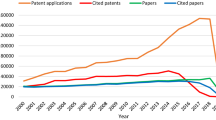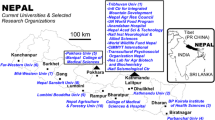Abstract
Pharmacology/pharmacy is an important scientific field and plays a pivotal role in new drug research and development. China has steadily increased investment in drug development. This study aimed to evaluate the productivity of China in the field pharmacology/pharmacy in the past decade in relation to ten representative countries. The publications in the field pharmacology/pharmacy of China and ten representative countries in the past decade (2001–2010) were retrieved from Web of Science database, and studies were conducted on the immediacy index of articles published in 2011. Multiple bibliometric indicators were obtained from the “InCites” analysis. Most of the bibliometric indicators for the developed countries including the USA and the European countries remained stable in the past decade. The number of publications by the Asian countries, especially China, increased dramatically in the past decade year by year; however, the Asian countries improved little in the indicators assessing the scientific quality of publications including the citation behaviors and the impact relative to either country and subject area. It may need a long time to fill in the gap, in terms of the scientific quality, between the developing countries and the developed countries. In view of the dramatic increase in the financial investment, our findings suggest that the development of the field pharmacology/pharmacy worldwide is not optimistic, which may partially explain the decreased R&D productivity of pharmaceutical industry since the last decade.










Similar content being viewed by others
References
Aksnes, D. W., & Rip, A. (2009). Researcher’s perceptions of citations. Journal of Informetrics, 38, 895–905.
Aversa, E. S. (1985). Citation patterns of highly cited papers and their relationship to literature aging: A study of the working literature. Scientometrics, 7, 383–389.
Bharathi, D. G. (2011). Methodology for the evaluation of scientific journals: aggregated citations of cited articles. Scientometrics, 86, 563–574.
Campanario, J. M., & Molina, A. (2009). Surviving bad times: the role of citations, self-citations and numbers of citable items in recovery of the journal impact factor after at least 4 years of continuous decreases. Scientometrics, 81(3), 859–864.
Derrick, G. E., Haynes, A., Chapman, S., & Hall, W. D. (2011). The association between four citation metrics and peer rankings of research influence of Australian researchers in six fields of public health. PLoS ONE, 6, e18521.
Fu, J. Y., Zhang, X., Zhao, Y. H., Tong, H. F., Chen, D. Z., & Huang, M. H. (2012). Scientific production and citation impact: a bibliometric analysis in acupuncture over three decades. Scientometrics, 93(3), 1061–1107.
Garfield, E. (1964). Science citation index: a new dimension in indexing. Science, 144, 649–654.
Garfield, E. (1972). Citation indexing—its theory and application in science, technology and humanities. New York: Wiley.
Guan, J. C., & Ma, N. (2004). A comparative study of research performance in computer science. Scientometrics, 61, 339–359.
Hopkins, A. L. (2008). Network pharmacology: the next paradigm in drug discovery. Nature Chemical Biology, 4(11), 682–690.
Hughes, B. (2010). China spurs pharma innovation. Nature Reviews Drug Discovery, 9(8), 581–582.
Larcombe, A. N., & Voss, S. C. (2011). Self-citation: comparison between radiology, European radiology and radiology for 1997–1998. Scientometrics, 87, 347–356.
Lu, J. J., Pan, W., Hu, Y. J., & Wang, Y. T. (2012). Multi-target drugs: the trend of drug research and development. PLoS ONE, 7(6), e40262.
Moed, H. F. (2002). Measuring China’s research performance using the science citation index. Scientometrics, 53, 281–296.
Pammolli, F., Magazzini, L., & Riccaboni, M. (2011). The productivity crisis in pharmaceutical R&D. Nature Reviews, 10, 428–438.
Price, D. (1963). Little science, big science. New York: Columbia University Press.
Price, D. (1965). Networks of scientific papers. Science, 149(3683), 510–515.
Radicchi, F., & Castellanoc, C. (2012). Testing the fairness of citation indicators for comparison across scientific domains: the case of fractional citation counts. Journal of Informetrics, 6, 121–130.
Rip, A. (1997). Qualitative conditions of scientometrics: the new challenges. Scientometrics, 38, 7–26.
Rowlands, I., & Nicholas, D. (2006). The changing scholarly communication landscape: an international survey of senior researchers. Learned Publishing, 19, 31–35.
Scannell, J. W., Blanckley, A., Boldon, H., & Warrington, B. (2012). Diagnosing the decline in pharmaceutical R&D efficiency. Nature Reviews Drug Discovery, 11(3), 191–200.
Smith, R. (2006). Commentary: the power of the unrelenting impact factor—Is it a force for good or harm? International Journal of Epidemiology, 35, 1129–1130.
Vieira, E. S., & Gomes, J. A. N. F. (2010). Citations to scientific articles: its distribution and dependence on the article features. Journal of Informetrics, 4, 1–13.
Vitzthum, K., Scutaru, C., Musial-Bright, L., Quarcoo, D., & Welte, T. (2010). Scientometric analysis and combined density-equalizing mapping of environmental tobacco smoke (ETS) research. PLoS ONE, 5, e11254.
Author information
Authors and Affiliations
Corresponding author
Additional information
Jian-Ping Ge—Co-first author
Rights and permissions
About this article
Cite this article
Ding, ZQ., Ge, JP., Wu, XM. et al. Bibliometrics evaluation of research performance in pharmacology/pharmacy: China relative to ten representative countries. Scientometrics 96, 829–844 (2013). https://doi.org/10.1007/s11192-013-0968-x
Received:
Published:
Issue Date:
DOI: https://doi.org/10.1007/s11192-013-0968-x




